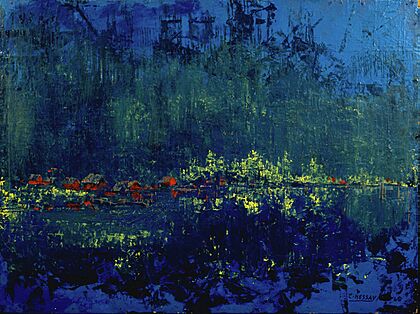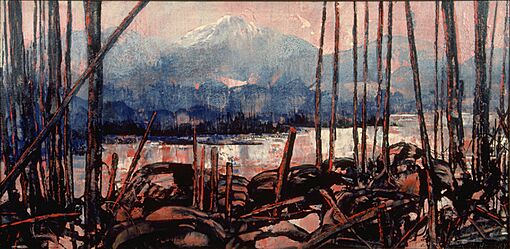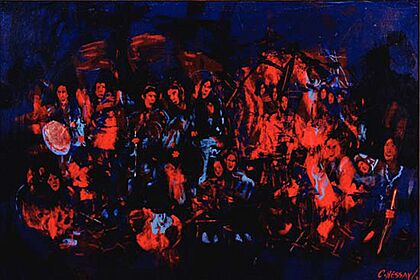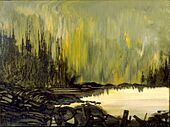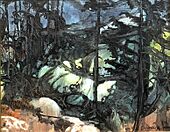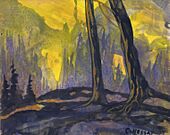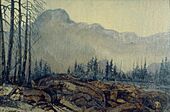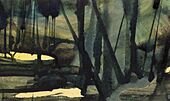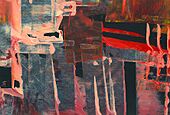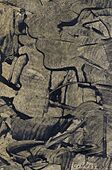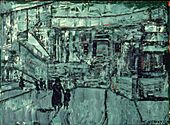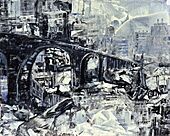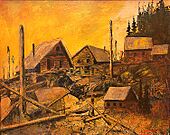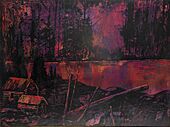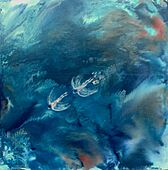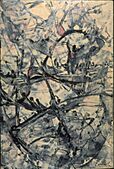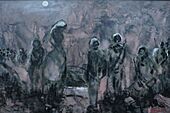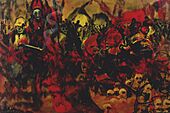Carle Hessay facts for kids
Quick facts for kids
Carle Hessay
|
|
|---|---|
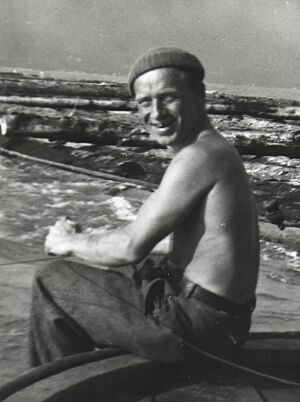
Carle Hessay on his boat, 1940s
|
|
| Born |
Hans Karl Hesse
30 November 1911 Dresden, Germany
|
| Died | 1 January 1978 (aged 66) Spuzzum, British Columbia, Canada
|
| Nationality | German Canadian |
| Education | Kunstakademie Dresden, École des Beaux-Arts, Paris |
| Known for | Painter |
| Movement | Expressionism |
Hans Karl Hesse, known later as Carle Hessay (born November 30, 1911 – died January 1, 1978), was a Canadian painter born in Germany. He moved to Canada in 1927. He studied art in Dresden and Paris.
Hessay fought as a Canadian soldier in World War II. After the war, he moved to British Columbia. He settled in Langley and started painting again in the 1950s. His early paintings were realistic. Later, he was greatly influenced by Expressionism, a style that shows strong feelings. He also took ideas from Canadian artists like Emily Carr and the Group of Seven.
Carle Hessay painted many landscapes. He also painted city scenes, the Spanish Civil War, and ideas about the future. Many of his works were abstract, meaning they didn't show real objects. His later paintings became more symbolic. Hessay often made his own paints. His art is known for its use of color, especially black. His work has been featured in books, films, and art shows.
Contents
Early Life and Adventures
Carle Hessay was born Hans Karl Hesse in Dresden, Germany, on November 30, 1911. He moved to Canada in 1927. He started painting when he was fourteen. He then went back to Europe to study art in Dresden and Paris.
Later, Hessay traveled the world as a sailor. He worked on ships for many years. He even became a second mate. He first saw British Columbia when his ship stopped in Port Alberni. He loved the area's climate and wanted to paint its mountains, sea, and rocks. Hessay also fought briefly in the Spanish Civil War. In 1938, he returned to Canada. He then served in the Second World War as a corporal in the Royal Canadian Engineers.
Life in British Columbia
After World War II, Hessay lived in a small cabin on Passage Island in British Columbia. He became a commercial fisherman.
In 1950, Hessay moved to Langley. There, he met Leonard Woods, a sculptor and artist. Woods described Hessay as going through a tough time. They became lifelong friends. Woods encouraged Hessay's art. Hessay also became friends with other artists like Peter Maxwell Ewart.
In Langley, Hessay opened a sign shop. He lived in a small area behind the shop. This space also became his art studio. He often closed his shop on weekends. He would travel to the Fraser Canyon to look for gold. He once had a small cabin near Spuzzum. Hessay enjoyed visiting First Nations reserves. He felt accepted there.
At first, his art showed his European training. But he soon started creating abstract paintings. These were inspired by new art styles in New York and California. He also painted many landscapes of the British Columbia wilderness. Hessay was part of the Federation of Canadian Artists. He showed his work in group exhibits and had his own shows. He died of a heart attack on January 1, 1978, in Spuzzum.
Carle Hessay's Art
Painting Materials and Techniques
Hessay loved to try different art materials. He was interested in the science of paint. He often made his own colors. He used minerals and tree resins he found during his gold prospecting trips. He even made black paint by grinding manganese. He also used cooked fruits and vegetables, like onion skins and carrots, to make dyes. Sometimes he used egg white and house paint. He prepared his canvases with many layers of gesso, a special primer.
Hessay often painted with a lot of energy. He would spill and drag colors across the canvas. This style is called action painting. He even used a toothbrush for one of his paintings!
Art Style
His early paintings from the late 1950s were in a style called Romantic realism. They were beautiful but not overly emotional. From his German background, he kept the strong feelings of Expressionism. He admired First Nations art and artists like Mungo Martin.
Hessay wanted his paintings to create a "new, original experience." His art often shows strong feelings and drama. Many of his works have bold, contrasting shapes. He used color to show a main emotion. Black was his special color. Some of his landscapes remind people of Emily Carr or the Group of Seven. Some of his abstract works don't show anything real. Others have hints of nature, guiding the viewer's eye. Some abstracts even look like rock formations from his prospecting trips.
Art Themes
Hessay's paintings explored many topics. These included modern cities, myths, the Bible, war, and futuristic visions. He liked his pictures to tell a story. But he let viewers decide what the story meant. When asked if his paintings were symbolic, he said, "of course they are."
His landscapes often put the viewer in the middle of wild nature. You might see tangled roots, fallen rocks, deep snow, or swamps. Some paintings hint at destructive forces, like the pink colors in From Here to Eternity or the bright hues in Magenta Fire. He often painted flames because he had seen unfairness and cruelty. His landscapes often show signs of human life, like old logging camps or cabins. Many paintings show his love for nature, like Above the Yalakom.
In 1967, he painted a large mural for a church in Langley. It showed a waterfall and mountains. This mural connected Bible stories to Canadian landscapes. His last painting, Break of Day (1977), was a peaceful landscape. It was different from his other late works, with soft colors and smooth shapes.
Hessay sometimes used religious ideas to talk about problems in modern society. The Number of Man is a complex painting with skulls and strange figures. It refers to the Book of Revelation. Some of his later works are spiritual, like Wake for a Shuswap. This 1971 painting shows a Secwepemc First Nations memorial around a fire. The people are in bright colors, surrounded by the dark night.
A few of his paintings show his experiences in the Spanish Civil War. One example is La Pasionaria (Dolores Ibárruri) at the Jarama River. Other war scenes are based on Bible stories or ancient history.
He painted a few cityscapes, showing his mixed feelings about cities. The Great City shows a clear, sharp city next to broken ruins. He also created a series of futuristic paintings called The Hollow World. These paintings imagined how civilization might look in the year 3000 A.D.
Personal Life
Hessay taught himself gymnastics. He trained on poles between two trees. In 1943, the Canadian Armed Forces called him a great gymnast and instructor. Even in his sixties, he would do handstands to entertain people.
Hessay believed music was the highest art form. He played the piano well. He often played music at the Lion's Club and the Canadian Legion to pay for his dinner. He loved listening to operas while he painted. Hessay was also very smart. He taught himself a lot about science, myths, and old philosophy. He could even quote classic literature by heart.
Legacy and Recognition
picking up
th brushbodee
breething pick up
kolourfinding th
surface
–bill bissett
opening lines of:
letting th brush
danse
(For Abstract #25)
Carle Hessay didn't get much recognition for his art during his lifetime. When newspapers wrote about his shows, they focused more on him than on his paintings.
In 1980, a special show of Hessay's art was held at the Langley Centennial Museum. It included photos, watercolors, and oil paintings. A critic from the Vancouver Sun wrote that his art showed the "still ringing voice of a man who reached into his soul."
In 2005, his friend Leonard Woods wrote a book about Hessay's paintings called Meditations on the Paintings of Carle Hessay.
In 2009, four of Hessay's The Hollow World paintings were shown publicly for the first time. These futuristic scenes were displayed with poems by different writers.
In 2014, a book of poems called For Kelly, with Love was published. Sixteen Canadian poets wrote poems inspired by Hessay's small abstract paintings. This project honored a poet named Kelly Parsons. The poets felt a connection between writing and painting.
A documentary film about Hessay was shown at the University of Victoria in 2017. It featured interviews with people who knew him or his art. The film ended with a poet performing a poem about Hessay's painting process.
Hessay's paintings are now in the collections of the Langley Centennial Museum and the Penticton Art Gallery. One of his paintings, Port City (1968), was even featured on the cover of a book in 2022.
Images for kids
Landscapes
Abstracts
Cabins to Cities series
The Hollow World series
The Spanish Civil War and Biblical prophecy
-
La Pasionaria (Dolores Ibárruri)
at the Jarama River. 1976.


